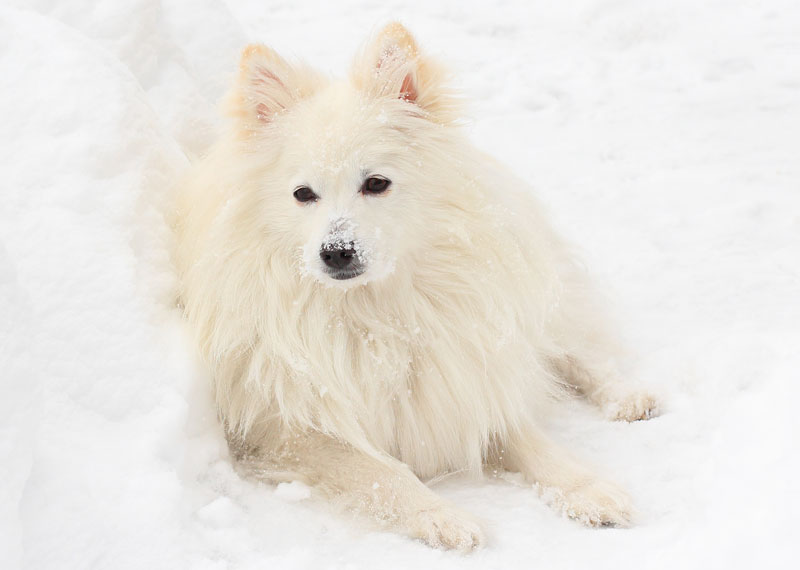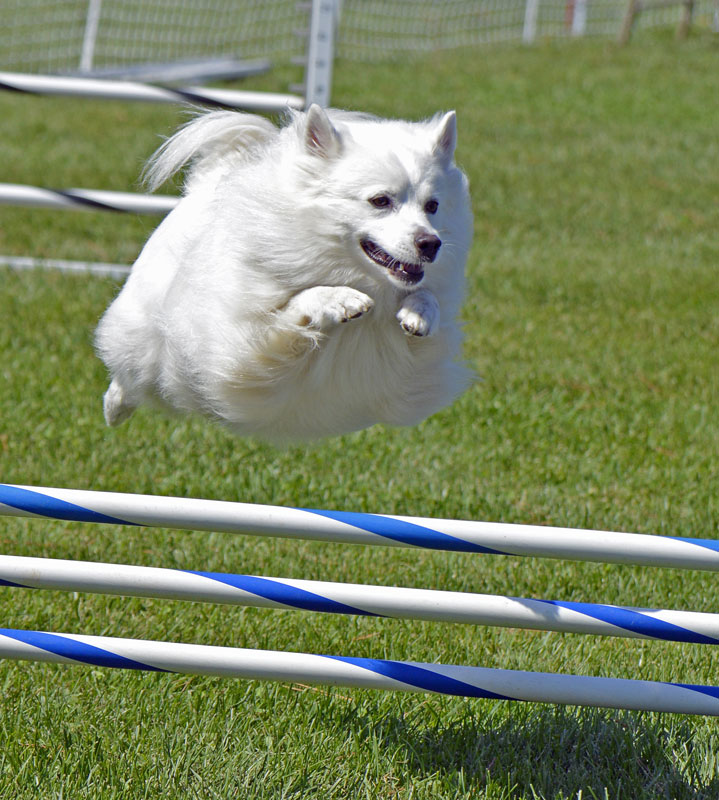The American Eskimo Dog is a breed of companion dog originating in Germany. The American Eskimo is a member of the Spitz family. Despite its name and appearance, the American Eskimo dog is not from Alaska; the dog's heritage is traced back to Northern Europe. The breed's progenitors were German Spitz, but due to anti-German prejudice during the First World War, it was renamed "American Eskimo Dog". Although modern American Eskimos have been exported as German Spitz Gross (or Mittel, depending on the dog's height), the breed standards are actually significantly different. In addition to serving as a watchdog and companion, the American Eskimo dog also achieved a high degree of popularity in the 1930s and 1940s United States as a circus performer.There are three size varieties of the American Eskimo breed, the toy, miniature and the standard. They share a common resemblance with Japanese Spitz and Samoyed.Miniature American Eskimos, with their high intelligence and inquisitive nature, will love to "investigate". If they find something very interesting they will often want their owner or handler to investigate as well, and will at times, not let the "matter" go until the person complies. You will often find this behavior when it comes to children; for instance, if a baby or child is crying, the American Eskimo will want you to see what the problem is and will not stop worrying until you do. The American Eskimo being so "tuned in" is one of the characteristics that makes them a desirable breed around children.
History
The American Eskimo Dog was originally bred to guard people and property and, therefore, is territorial by nature and a valiant watchdog. They are not considered an aggressive breed. But, due to the breed's watchdog history, American Eskimos are generally quite vocal, barking at any stranger who comes in proximity to their owners' territory.In Northern Europe, smaller Spitz were eventually developed into the various German Spitz breeds. European immigrants brought their Spitz pets with them to the United States, especially New York, in the early 1900s, "all of them descended from the larger German Spitz, the Keeshond, the white Pomeranian, and the Italian Spitz, the Volpino Italiano."Although white was not always a recognized color in the various German Spitz breeds, it was generally the preferred color in the US. In a display of patriotism in the era around World War I, dog owners began referring to their pets as American Spitz rather than German Spitz.After World War I, the small Spitz dogs came to the attention of the American public when the dogs became popular entertainers in the American circus. In 1917, the Cooper Brothers’ Railroad Circus featured the dogs. A dog named Stout's Pal Pierre was famous for walking a tightrope with the Barnum and Bailey Circus in the 1930s, and also contributing to their popularity, they sold puppies after the show. Due to the popularity of the circus dogs, many of today's American Eskimo Dogs can trace their lineage back to these circus dogs. At that time there was no official breed club and no breed standard, and dogs were accepted for registration as single dogs, based on appearance. In 1970 the National American Eskimo Dog Association (NAEDA) was founded, and single dog registrations ceased. In 1985 the American Eskimo Dog Club of America (AEDCA) was formed by fanciers who wished to register the breed with the American Kennel Club (AKC). Following the AKC's requirements for breed recognition, the AEDCA collected the pedigree information from 1,750 dogs that now form the basis of the AKC recognized breed, which is called the American Eskimo Dog. The breed was recognized by the American Kennel Club in 1995. The stud book was opened from 2000 to 2003 in an attempt to register more of the original UKC registered lines, and today many American Eskimo Dogs are dual-registered with both American kennel clubs. but is not recognized elsewhere in the world
The American Eskimo Dog is not entirely an internationally recognized breed, and since neither of the American kennel clubs are affiliated with the Fédération Cynologique Internationale, fanciers wishing to participate in certain international dog shows will register their American Eskimo Dogs as the very similar German Spitz. This is done only by individuals wishing to participate in dog sports in international shows, and does not mean that the American Eskimo Dog and the German Spitz are the same. Although the American Eskimo is known as the German Spitz in several countries outside of the United States, the two breeds have actually developed somewhat differently since the American Eskimo was relocated to North America, over a century ago. It is not uncommon for German Spitz breeders to incorporate imported American Eskimo bloodlines into their breeding program to broaden the gene pool, and vice versa.
Health
The American Eskimo is a hardy breed with an average life span of 16 years. This breed tends to become overweight easily, so proper diet and exercise is needed to maintain an overall well being. Health testing should be performed by all responsible breeders and anyone purchasing a puppy should be aware of the genetic problems which have been found in some individuals of the breed, such as PRA (Progressive Retinal Atrophy), luxating patella, and Hip dysplasia (canine)). None of these problems are common and the breed is generally very healthy. In addition to the rarer problems mentioned, the breed can have a tendency towards allergies and most commonly, tear-staining. This breed also is known in some cases to have dental issues.





